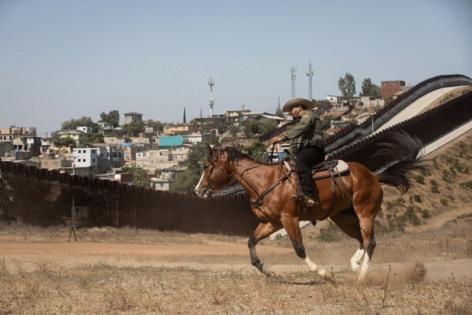Border Patrol horses return to San Diego as migrant encounters continue to plummet
Published in News & Features
SAN DIEGO — After a two-year hiatus, a small group of U.S. Border Patrol agents is once again patrolling the border on horseback — from the beach to the wilder terrain of San Diego's East County region.
Horses date back to the federal agency’s origins a century ago and are still used along the U.S.-Mexico border in part for their ability to move through challenging environments.
Border enforcement with horses has also made headlines in recent years, including agents on horseback confronting a group of Haitian migrants on the Rio Grande in Texas, as well as earlier this month as part of a recent attempted immigration sweep at Los Angeles’ MacArthur Park.
The return of the mounted unit comes as border apprehensions have dipped to historic lows along the U.S.-Mexico border. Ironically, it’s the low numbers that allowed the unit to come back.
For decades, the mounted unit operated along the San Diego border. In 2023, however, it was reassigned to other sectors. At the time, local Border Patrol personnel had to focus their resources on addressing the growing number of migrants arriving at the border, many of whom were seeking asylum, officials said.
“We were kind of just overrun with people crossing the border, and the priority was just processing,” recalled Victor Roldan, the unit’s lead instructor in the San Diego sector.
“Now things have slowed down,” he added. “We have more manpower to get ... these guys back on horses.”
Last month, the San Diego sector recorded 895 migrant encounters, a 96% decrease compared to the same time last year, according to data released by U.S. Customs and Border Protection this past week.
The San Diego sector first announced the unit’s return in March on social media, saying it marks a “continuing long-standing tradition within the Border Patrol.”
The unit is composed of 12 horses and 10 agents: seven riders, two instructors and a supervisor. San Diego is one of eight Border Patrol sectors nationwide with a mounted unit — one is in the Spokane sector, which covers a stretch of U.S.-Canada border in the Northwest, while the rest are along the U.S.-Mexico border. The unit keeps barns in Imperial Beach and Boulevard.
The four-legged unit has its advantages, such as its ability to access places that some vehicles cannot — horses can get to some out-of-the-way locations faster than agents on foot and more quietly than an ATV, Roldan said. He also noted that while an ATV is faster than a horse, “they can be heard from over a mile away.” Horses can also access environmentally sensitive areas.
The unit patrols areas from the beach to the East County mountains.
“The busiest area along the border is where we go,” Roldan said. “That’s the times of the day or night that we work, and the areas we work, wherever it’s busiest. Wherever they need the most help, it’s where we head to.”
Still, it may be rare to come across the unit in the field.
María Teresa Fernández, who has been photographing the area around Friendship Park on the border between San Diego and Tijuana for nearly two decades, recalled coming across Border Patrol agents on horseback in the area in 2012. She still remembers how their presence caught her attention, as it was the first and only time she had seen them at the site.
“I was curious,” she said.
Pedro Ríos, the director of the American Friends Service Committee’s U.S.-Mexico Border Program, said he does not recall encountering the horse unit before. But he expressed concern over the ability of independent federal watchdog monitors to provide accountability for the horse program if needed, as the Department of Homeland Security has continued to shrink its watchdog office.
Advocates pointed to an incident in Del Rio, Texas, that sparked public furor a few years ago.
In late 2021, Border Patrol agents on horseback violently confronted a group of Haitian migrants at the Rio Grande border, in an incident that was caught on video.
The Rio Grande horse unit was suspended, and, according to a 2022 investigation, the agents involved deployed “unnecessary use of force against migrants.” Among the findings of the investigation were offensive comments, dangerous maneuvers and agents twirling their horse reins. One agent was also found to have grabbed a migrant by his shirt and spun him around.
“There were failures at multiple levels of the agency, a lack of appropriate policies and training, and unprofessional and dangerous behavior by several individual agents,” Customs and Border Protection, Border Patrol’s parent agency, said at the time.
As a result, the agency pledged to take a series of corrective actions. “These include changes to practices, training, and operational methods to address management failures that contributed to the incident, stricter limits on the use of the horse patrol, and strengthening leadership and agency accountability,” the agency said.
Earlier this month, Border Patrol agents on horseback were seen at a nearly empty MacArthur Park in Los Angeles, reportedly as part of an immigration enforcement operation involving several federal agencies. No arrests were reported. A Border Patrol spokesperson said that the horse unit was not from San Diego.
Horses are often used for both apprehension and rescue operations in the San Diego sector, officials said. Although officials could not provide specific statistics about the unit, they said that it has assisted “many times” with both.
“There’s a lot of training that goes into the horses also before we let them out into the field. So they’re pretty desensitized,” Roldan said. “We don’t really have to worry about them kicking ... at anybody. They’re very well-mannered by the time they get out to the field.”
To join the unit, there is a tryout and then a four-week training program. The program is designed to make someone without riding experience become comfortable on a horse. But there is still a long way to go, said Roldan.
“It takes a couple years of riding every single day to actually become a really good rider,” he said.
Roldan, who started his Border Patrol career in the El Centro sector, said he didn’t have much experience riding before joining the unit. “I had family that had horses, and they would kind of just throw me on the horse, and I would just hold on, you know?” he said.
Later, he became a certified instructor and was transferred to San Diego. He’s been involved with a horse unit for eight years now, he said.
Horses were pretty much all the agents had back when the Border Patrol was formed in 1924.
For a period in the 1950s, the horse patrol went away as most of the operations were conducted in vehicles. Roldan said that in 1979, the San Diego sector was the first unit to bring the horse patrol back.
Other law enforcement agencies in San Diego County have a history with mounted units, including the San Diego Police Department, which disbanded its unit in 2009 due to budget issues.
The Sheriff’s Office has a volunteer mounted unit, made up entirely of volunteers and their horses. The unit assists with urban street patrols, holiday watch patrols in commercial parking lots, as well as parade routes, memorial services, and meet-and-greets at law enforcement events and schools, according to its website.
_____
©2025 The San Diego Union-Tribune. Visit sandiegouniontribune.com. Distributed by Tribune Content Agency, LLC.







Comments